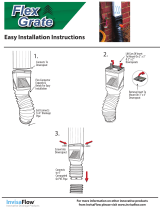
nVent.com | 5
HEATING CABLE DESIGN
Only WinterGard Wet H612 120 V heating cable is suitable for
use with the H908 power connection kit for roof and gutter
de-icing applications.
1. Calculate the heating cable length required.
Length
=
A
+
B
+
C
+
D
+
E
+
F
+
G
A Roofedgelength(ft)xfeetofheatingcableperfootofroofedge
(From Table 5)
B Roofedgelength(ft)x0.5*
C Total gutter length (ft)
D Total downspout length (ft) + 1 (ft)
E 1 ft for each power connection
F 2 ft for each splice connection
G 3 ft for each tee connection
= Total heating cable length (ft)
*Roofextension:Thislengthallowstheheatingcabletoextendintothegutter
toprovideacontinuousdrainpath,orwherenoguttersarepresent,extends
beyond the roof edge to form a drip loop.
Table 5. WinterGard Wet cable length for roof de-icing
Standing seam metal roof:
Eave overhang Shingle roof 18 inch seam
24 inch seam
0 2.0 ft 2.5 ft 2.0 ft
12 in 2.8 ft 2.8 ft 2.4 ft
24 in 3.8 ft 3.6 ft 2.9 ft
36 in 4.8 ft 4.3 ft 3.6 ft
Note: nVentrecommendsagutteranddownspoutstoprovideacontinuous
path for melted water.
Important: ForthenVentwarrantytobevalid,youmustcomply
with all the requirements outlined in these guidelines.
Alldesigninformationprovidedhereisbasedona“standard”
shake or shingle roof application. For any other application or
method of installation, consult nVent at (800) 545-6258.
HEATING CABLE INSTALLATION
1. Prepare for installation.
• Store the heating cable in a clean, dry place.
• Use only the following RAYCHEM accessories to satisfy code
and agency requirements:
- H908 Plug-in Power Connection Kit (with end seal)
- H910 Splice and Tee Kit (if splicing or teeing)
- H915 Downspout Hangers
- H913/H914RoofClips
• Carefully plan the routing of the heating cable for roof and
gutter de-icing.
• Makecertainguttersanddownspoutsarefreeofleaves
and other debris.
2. Cut the heating cable to length.
• Cut the heating cable to the length required before or after
itisinstalled.Leaveaminimumof1footextraheatingcable
for connection to power. For splice and tee connections
leaveaminimumof1footforeachsectionofheatingcable.
WinterGard heating cable can be cut to length without affecting
its heat output per foot.
• Protect the heating cable ends from moisture and mechanical
damageiftheywillbeleftexposedbeforeconnection.
3. Position and attach the heating cable.
On roofs
• Looptheheatingcableontheoverhangareaoftheroof.Thisisthe
partthatextendspastthebuildingwall.Extendthebottomofeach
heatingcableloopovertheroofedgeand,usingaUV-resistant
cable tie, connect the bottom of each loop to the cable running in
the gutter to ensure a drainage channel off the roof and into the
gutter and downspout. The cable running in the gutter should remain
againstthebottomofthegutter.Extendthetopofeachheating
cable loop beyond where the wall joins the roof. nVent recommends
2-foot clip-spacing along the roof edge. See the “Heating cable
design” section (Table 5) for spacing and layout information.
• UseWinterGardH913/H914roofclipstoattachheatingcable
to the roof surface. One kit contains ten double roof clips for
approximately7linearfeetofroofedge.OneH914kitcontains
50roofclipsforapproximately35linearfeetofroofedge.
For flat roofs, the heating cable can be spaced as needed to
create runoff paths for melting ice and snow. Use single-ended
clipslocatedat3-footintervalstosecurethecabletotheroof.
Roof clips may be attached to a shake or shingle roof with nails
or screws. Roof clips may be attached to a metal roof using
screw,nailoradhesive.(SeeH56723installationinstructionfor
more details.) Reseal the nail or screw holes if necessary before
installing heating cable in the clips.
• Abarrier(snowfence)canbeplacedontheroofabovethe
heatingcable.Thispreventsdamagetothecableandkeepsthe
installation from coming loose due to ice slides. The heating
cable can be attached to the barrier with UV-resistant cable ties,
instead of using roof clips, if desired. Do not use wire or other
materials because they may damage the heating cable.
In gutters and downspouts
• Run heating cable along gutters and into downspouts, ending
belowthefreezinglevel.Permanentattachmentofthecableto
the gutter bottom is not necessary. Loop the heating cable in
downspoutsifconvenient,suchaswhenthedownspoutisnot
at the end of the run, or use the H910 splice and tee kit to tee
down the downspout.
• Use WinterGard H915 downspout hangers to protect the heating
cable from fraying and from damage from sharp edges and
toprovidestrainrelief.RefertotheH915kitinstructionsfor
installation details.
• UseWinterGardH913/H914roofclipstorouteheatingcable
intoandoutofthegutterinsuchawayastopreventabrasion
to the cable. Protect all cable that protrudes past the lower
opening of the downspout.
H908 DESIGN AND INSTALLATION INFORMATION FOR ROOF AND GUTTER DE-ICING ONLY
(WinterGard Wet H612 Heating Cable)
Example:
Roof edge: 20 ft
Roofoverhang: 1ft
Roof gutter: 20 ft
Downspout: 15 ft
Power connection: 1 ea
Tee connection: 1 ea
Voltageavailable: 120V
CBSizeAvailable: 15A
Start-up temperature: 0 °F
WinterGard Wet heating cable required:
ARoofedge: 20ftx2.0
(fromTable5) =40ft
BRoofextension: 20ftx0.5 =10ft
CRoofgutter: =20ft
DDownspout: =15ft+1ft =16ft
EPowerconnection: 1ftx1ea =1ft
FSpliceconnection: =0
GTeeconnection: 3ftx1ea =3ft
Total WinterGard Wet
heating cable required: 90 ft**
**Thistotalislessthan100-ftmaximumcircuitlength
(see Table 6), therefore a single circuit is required




















